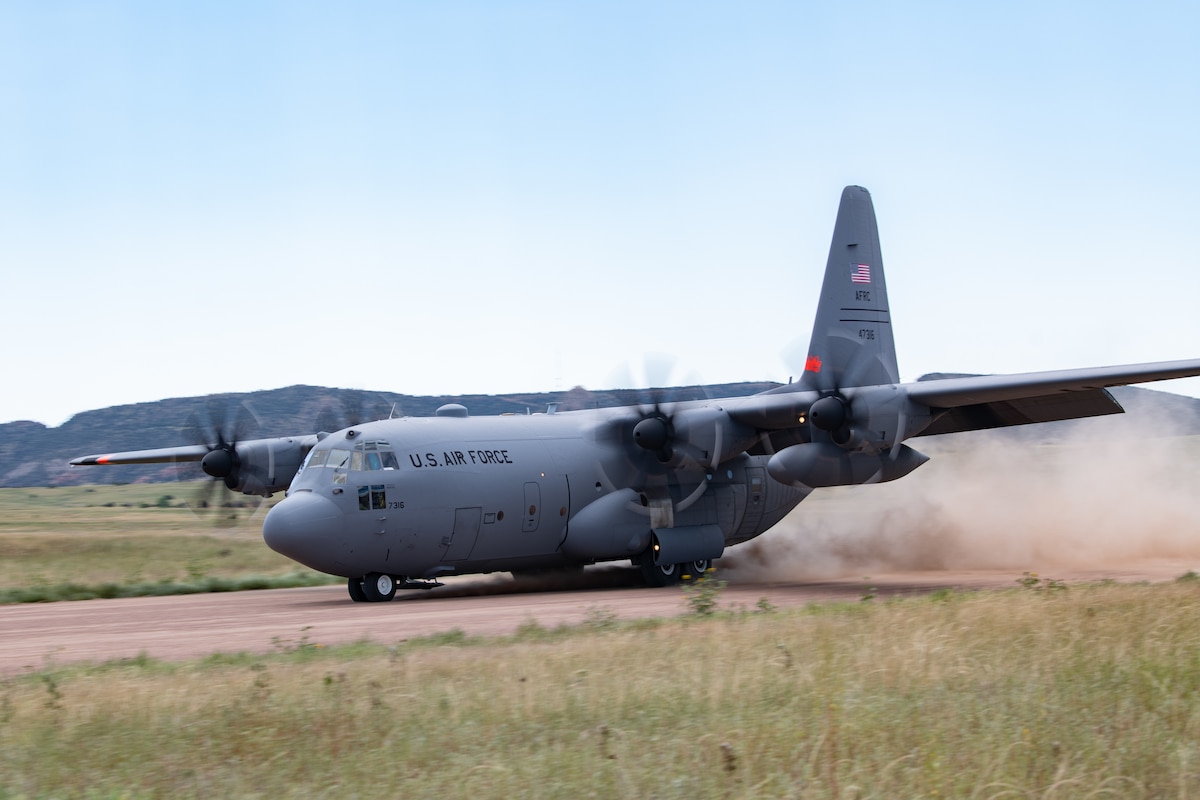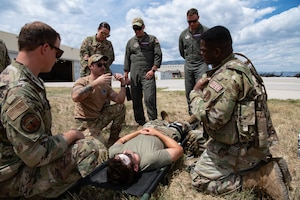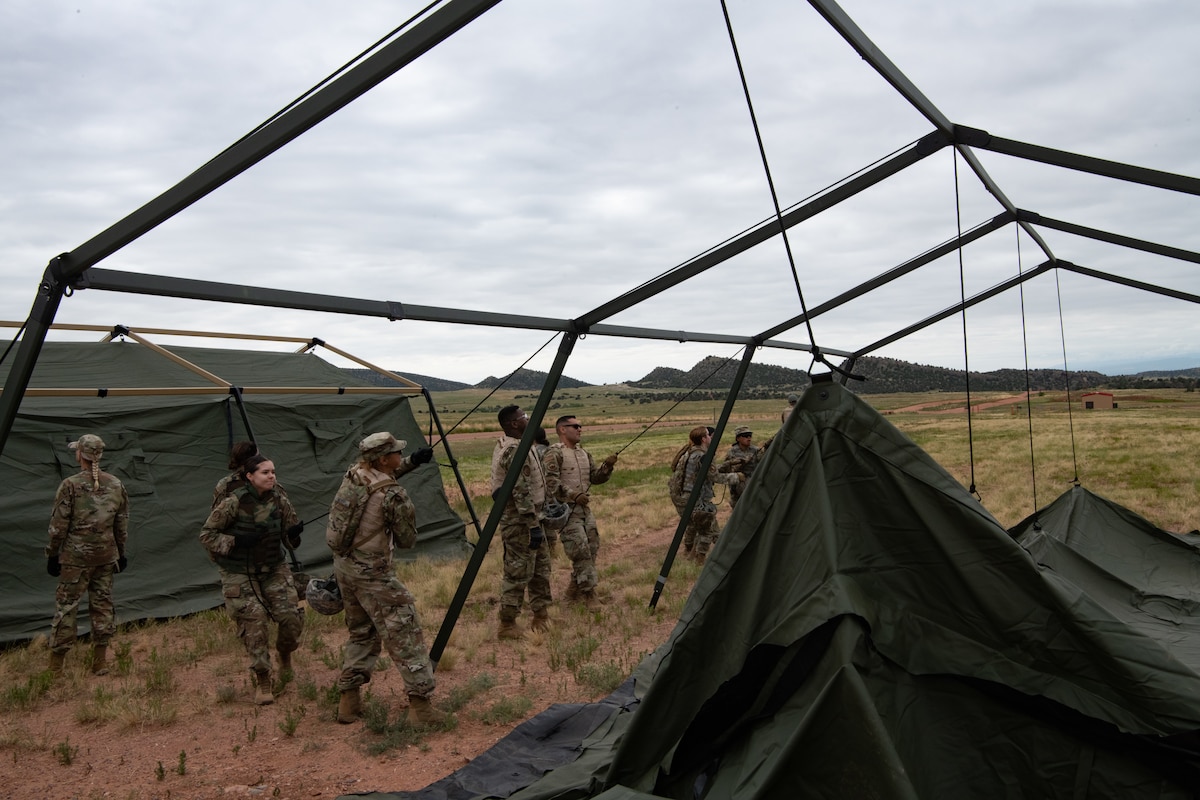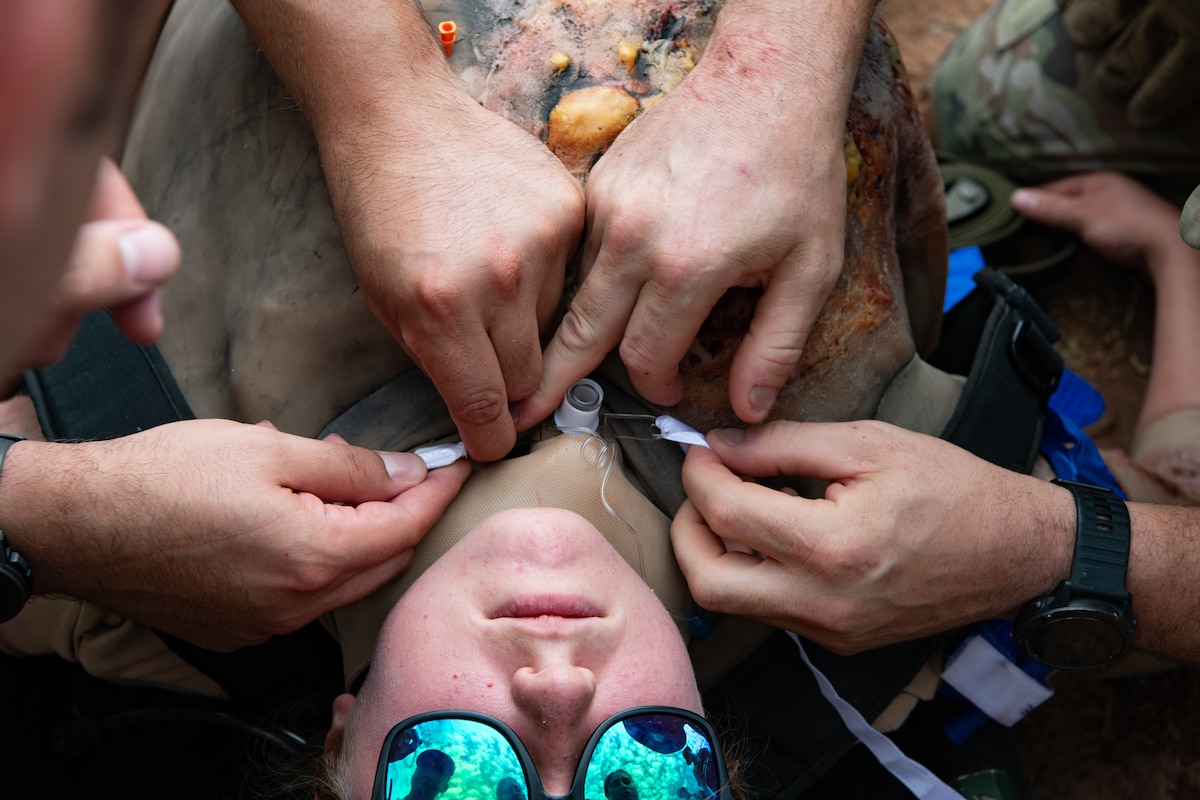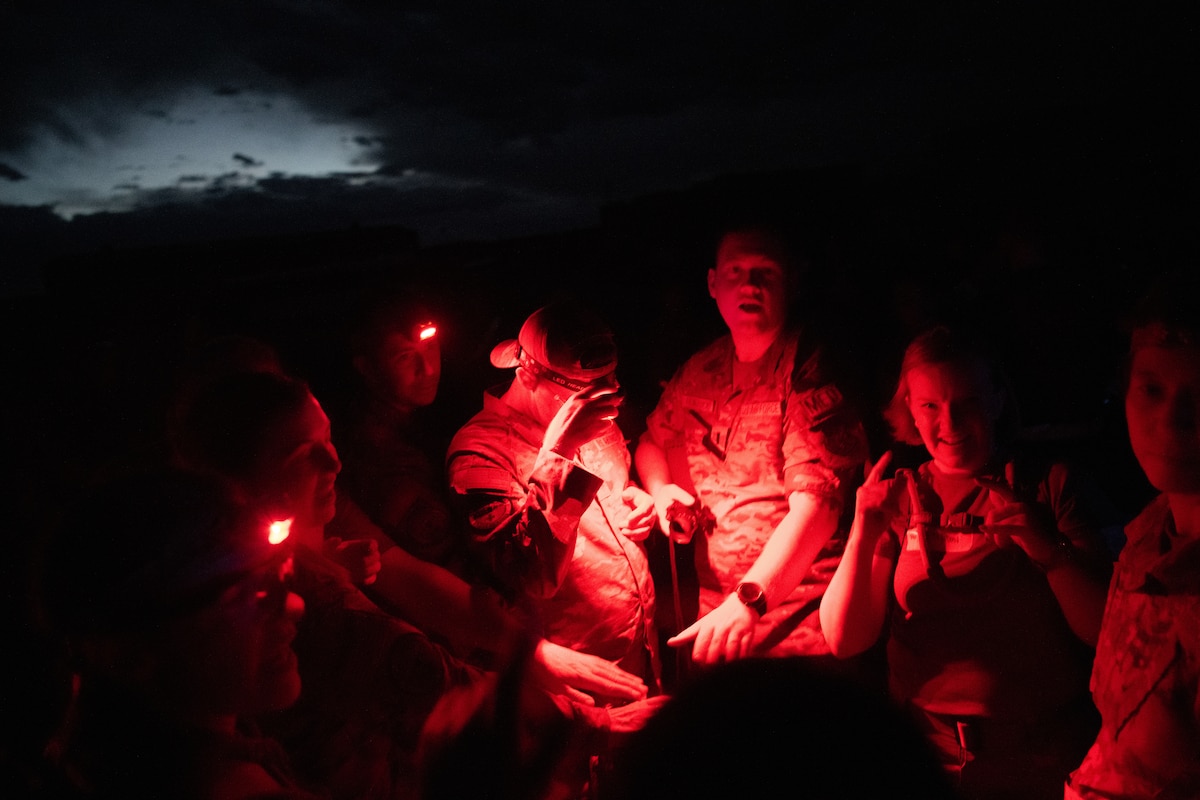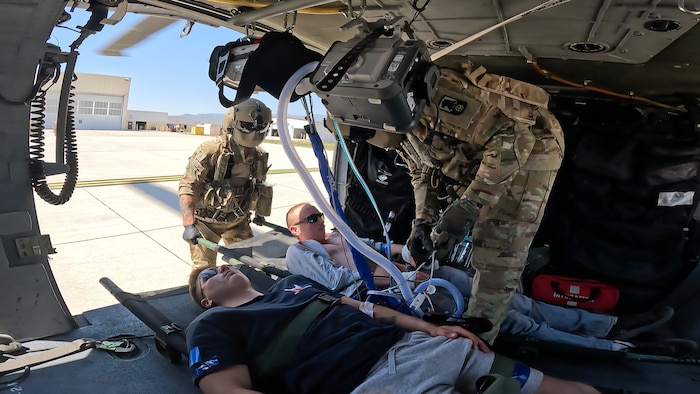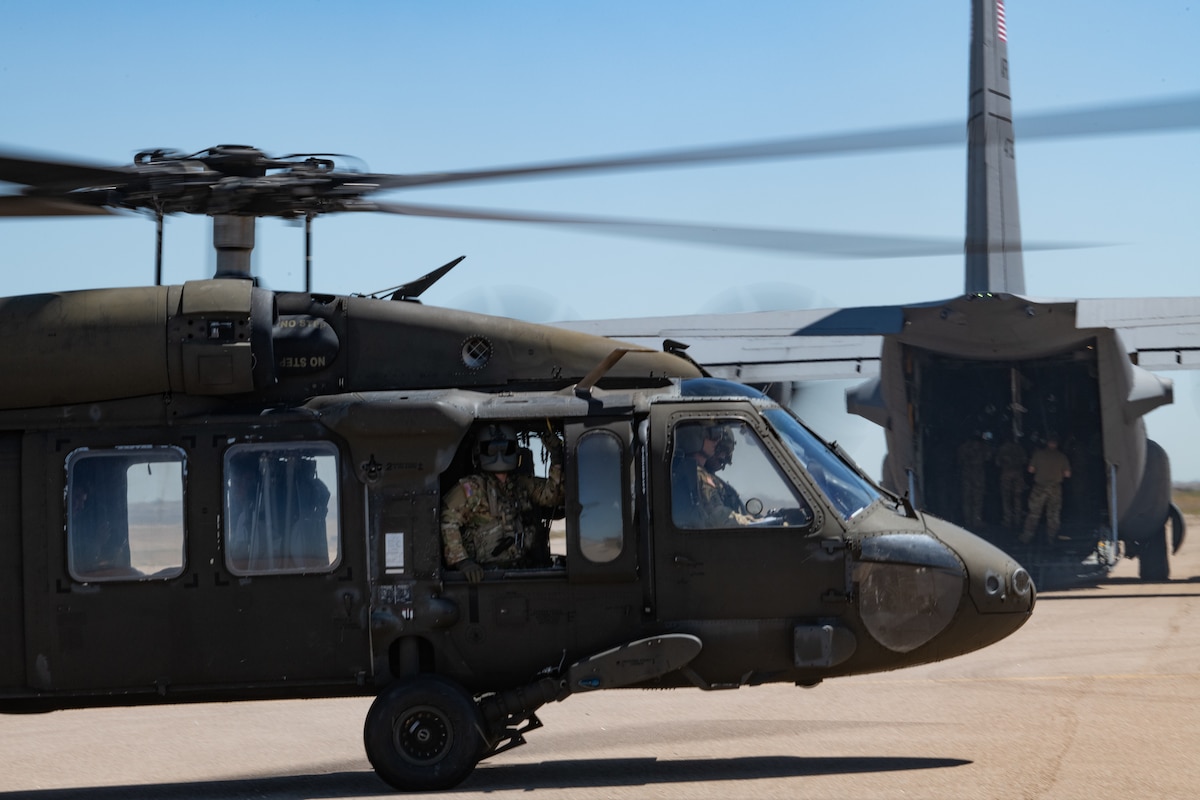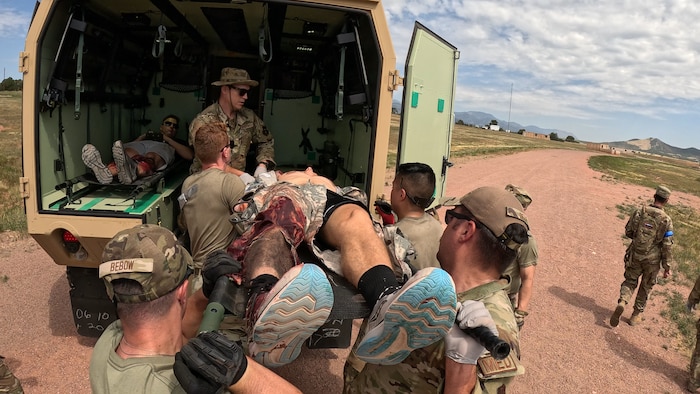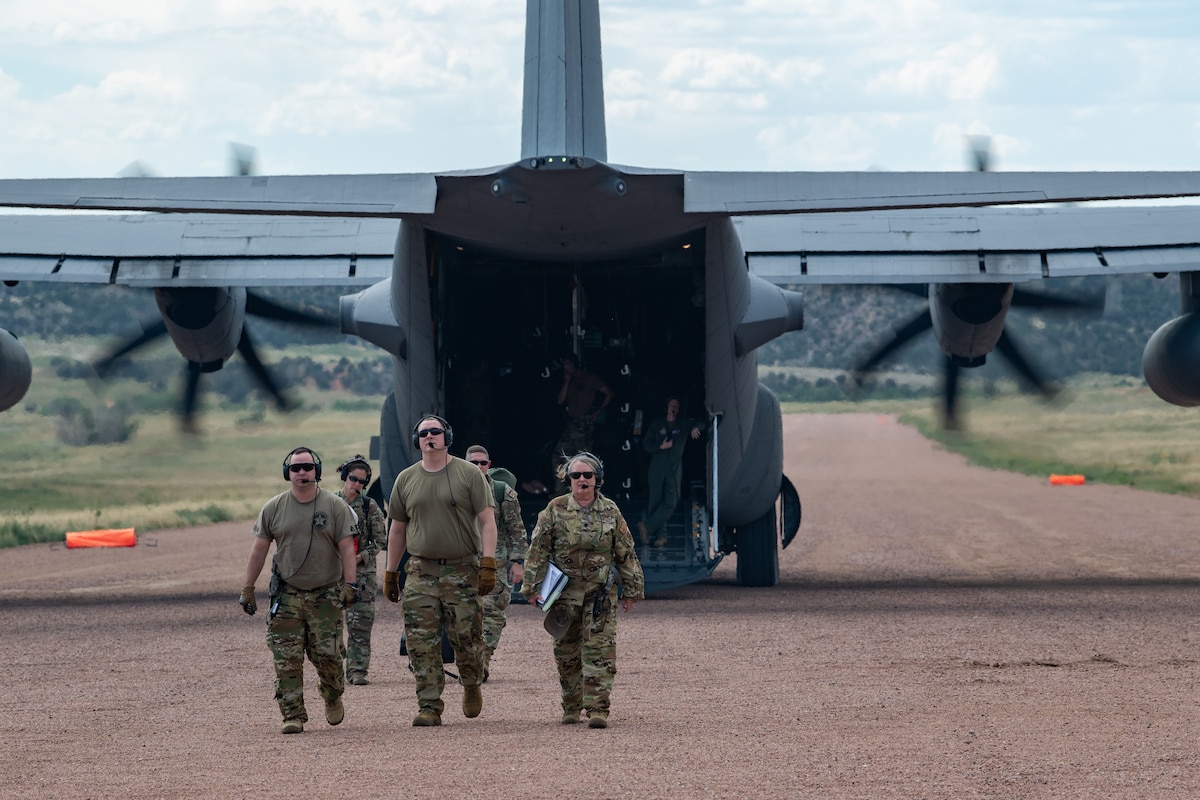Soldiers, Airmen and Guardians from multiple units participated in Exercise Mountain Medic 23, designed to simulate the evacuation and treatment of injured personnel in a joint-service austere battle zone throughout Colorado recently.
The two-week-long exercise began with five days of classroom training, followed by hands-on training in an instructor-led environment and in-person familiarization with the C-130 Hercules aircraft and UH-60 Blackhawk helicopters. The following week, they engaged in scenario-based air and ground medical evacuation exercises in different locations.
"This was a multi-domain, multi-component, joint environment exercise designed to test the medevac and aeromedical response to a large-scale combat operation," said Lt. Col. Jennifer Housholder, Army Reserve Aviation Command UH-60 pilot. "We're working together between the services to take the wounded and get them where they need to be. At the end of the day, that's all that matters."
Total force members shared knowledge with each other gleaned from their military experiences and expertise during the exercise. Reservists with civilian jobs in the medical field also shared what they've learned through their time treating patients outside of a military environment. Participants also learned about how each service operates differently and collaborated on what the best practices were for different treatments and procedures.
"There are a whole bunch of resources, other units, other entities that are looking to do the same thing we are," said Col. James Bershinsky, 302nd Aeromedical Staging Squadron commander. "We just have to reach across the line, build a realistic training platform and innovate and adapt as we would be expected to do the next fight. We need to do a better job of resourcing and training our joint force to get the most modern techniques."
Exercise participants formed two joint-service groups over the first week as they reviewed the basics of tactical combat casualty care, practiced how to draw and transfer blood to each other, applied tourniquets and learned about K-9 care. They also learned the procedures for carrying and transporting injured and wounded from the point of injury, whether in the field or during a mass casualty scenario.
"Seeing everybody engage from every branch, it doesn't matter what rank you are," said 1st Sgt. Jens Pietrzyk, 7-158th Aviation Regiment critical care flight paramedic. "Everybody's in there sharing knowledge, and everyone's putting hands on the training, really wanting to learn. It's always amazing to see that whenever everybody comes into a room, we're here to learn."
Guardians also taught the group what Space Force assets are capable of and what they bring to the fight in a joint combat environment, ensuring that air and ground teams could communicate effectively by providing GPS capabilities.
"The space domain cuts through all other domains, whether it's land, air, sea or cyber," Housholder said. "Everything we do is predicated on the capabilities that the Space Force affords us. We have to train within that integrated context because that's how we're going to fight in the future."
After the instructor-led training concluded, each team reported to their respective duty locations the following Monday to begin the scenario-based training.
United States Air Force Academy cadets, Airmen, Soldiers and Guardians were selected in advance to act as patients. Fabricated wounds were created using moulage intended to recreate the likeness of real injuries. Some simulated patients were outfitted with open wounds on their limbs and neck, while others had facial trauma or disfigured appendages.
The live role-players were given a character to act out, complete with fake names and sources for each of their injuries. Some role-players were directed to act out specific behaviors, including psychological injuries, asphyxiation, blindness and deafness.
"It's going to be a crescendo," Bershinsky said. "We're going to start with smaller levels of patients getting through, and as that system gets busier, we're going to find breakpoints and weaknesses, overload that system and pile onto those weaknesses. Over the course of the week, that tempo will rapidly build to a point where we purposely break aspects to find better ways to do it."
An Air Force medical team arrived Monday at a predetermined location and stayed overnight at the end of each day. Their task was to set up an expeditionary medical treatment facility with an en route patient staging squadron mission. On an empty patch of dirt, the Airmen worked together, putting up tents staged with medical and communications equipment. Each tent served a specific purpose depending on the severity of the patient's condition and the needs of the medics manning it.
At the same time, a surgical team set up a working area at the original classroom training location equipped with tools to receive patients in need of a higher degree of care. Nearby, a fleet of UH-60s was prepared to be crewed in response to patients in need of aerial extraction.
Army aviators touched down at the Air Force expeditionary medical treatment facility with the first round of patients on board picked up from a location on Fort Carson. While in route, the crew on board treated, assessed and documented the extent of the patient's injuries.
"When there's an injury on the field that can't be transported by ground or needs faster care, usually they need a trauma surgeon within an hour," said Spc. Adam Diefendorf, 5-159th General Support Aviation Battalion UH-60 flight paramedic. "We have an idea of what we go into, but even when we get on the ground, we have to launch quickly per medevac doctrine. We get a report from the medic that's on the ground and then we load them up quickly because there's potential enemies in the area and we need to get them where they need to go within that hour of injuries sustained."
The flight medic opens the side door and motions for ground medics to approach the aircraft as a team of four. Airmen positioned themselves on each corner of the litter and carried the patient off the helicopter toward one of the tents for further treatment.
During the second day, a 302nd Aeromedical Staging Squadron team set up a simulated treatment facility in a hangar at the Pueblo Memorial Airport. There, they practiced offloading patients from UH-60s, securing them into the back of a medevac truck and driving them to the hangar for further treatment and evaluation.
They also trained how to receive patients from a UH-60 and transfer them into the cargo bay of a C-130H outfitted for aeromedical evacuation and personnel transport. When a helicopter landed with a patient on board, their engines remained operational. A team approached the helicopter with the blades spinning overhead, offloaded the patient and carried them to the nearby C-130 with its engines also running. They were guided aboard by 34th Aeromedical Evacuation Squadron Airmen in the cargo bay.
"I've never loaded patients onto a Blackhawk before," said Senior Airman Taylore Araki, 944th Aeromedical Staging Squadron aerospace medical technician. "Just seeing how it's done, then actually getting to do it and realizing that there was more to it than I thought was really good practice. Surprisingly, it wasn't as difficult as I assumed it was going to be."
Patient transfer training occurred again at Fort Carson when a C-130 landed on a dirt runway close to the expeditionary treatment facility. Participants used an ambulance bus provided by the Department of Veterans Affairs to load patients for transport, drive them to the C-130 on the dirt runway and reverse the vehicle close to the cargo ramp of the aircraft. 34 AES Airmen directed the transport of the patients into the bay from the rear of the bus.
During flight, the patients were treated and monitored by the medics on board. A Critical Care Air Transport Team augments the standard aeromedical evacuation crew aided by Army UH-60 flight medics training alongside them. These specialized teams care for critically ill or injured patients during flight while they're transported to a higher level of care.
"I realized how much the CCAT teams are capable of because they have so many people on the team providing care versus myself in the back of a Blackhawk," said Diefendorf. "When we're turning and banking, I'm getting thrown around and there's only so much I can do in 15-20 minutes. Whereas the CCAT teams have more people with more hands-on, they're able to do so much more in the same amount of time."
On the final day of the exercise, participants were faced with a mass casualty training scenario.
Medics and 10th Special Forces Group Green Berets located role-players in dark rooms, assessed their injuries and evacuated them to the expeditionary treatment facility for further care. Panicked role-players were comforted, and combative ones subdued while the team cleared obstacles keeping them from providing care to the injured.
"It was very chaotic," said Araki. "I was stressed but I just remembered these are our patients and they need to get treated immediately. These are people's loved ones. I think that was the pusher to get through it. These people need help, and they want to go home and see their families."
Senior Airman Taylore Araki, 944th Aeromedical Staging Squadron
They brought in litters to transport those who couldn't walk. If a litter wasn't available, patients were carried or shoulder-dragged to safety. When they finished securing one patient, they returned to the building to find another, working amidst the screaming in the darkness until all injured were removed and en route to the expeditionary treatment facility.
"For my injuries, I had facial trauma," said Senior Airman Zadok Dean III, 34 AES aeromedical evacuation technician, who role-played during the mass casualty exercise. "The way I played it, I was crawling around, asking for help. It was really cool to see the mass casualty being the patient, getting dragged out by one of the medics and then going to camp and getting taken care of. Being a part of that process really put into perspective how a patient feels. We have some really good people who know what they're talking about taking care of us."
As patients from the mass casualty were evacuated by C-130 or UH-60, the exercise came to a close shortly afterward.
Looking forward, Airmen and Soldiers from junior enlisted up to leadership expressed the need to expand the scope of the scenarios, involve more missions, invite other organizations to participate and accomplish the training on a more frequent basis.
"It's not just medevac and aeromedical," said Housholder. "Anything we do will cross into multi-domain, multi-component and joint environments. Even as an air assault Blackhawk pilot, I'm not doing it outside of a joint environment, not in today's world. We need more integration. We have to get after training and exercising in an integrated way because that's the only way we fight."
Housholder introduced the idea of integrating the Navy into future exercises, suggesting training with the capabilities of their rotary and fixed-wing aircraft included in their air ambulance detachments. She also cited hoist operations the Coast Guard performs over water as another possible component of training.
"I thought this was the best training I have genuinely ever received in my aeromedical evacuation career," said Dean. "Mountain Medic should 1,000% not be a once-a-year thing. We don't get to work with other branches, and we don't get to see how other people operate in an environment like this. Getting this type of training builds so much confidence in myself as a medic and I know several of my other coworkers feel the exact same way."
The Air Force ground medical team gathered for an after-action discussion at the end of the exercise, highlighting successes and pitfalls throughout the field portion of the training. Bershinky addressed the multi-squadron team directly.
Col. James Bershinsky, 302nd Aeromedical Staging Squadron
"How ready is ready enough?" said Bershinsky. "Everybody in this room is here to support the warfighter. We're here to take care of them when they're in trouble. We're all family; we all wear this uniform. That's our family member who may very well be lying in that situation. So, ask yourself, how much training is enough? My challenge to you is to hold yourself to a very high standard. Good enough is not good enough. Once you reach that standard and it becomes your norm, then you raise that bar yet again."


